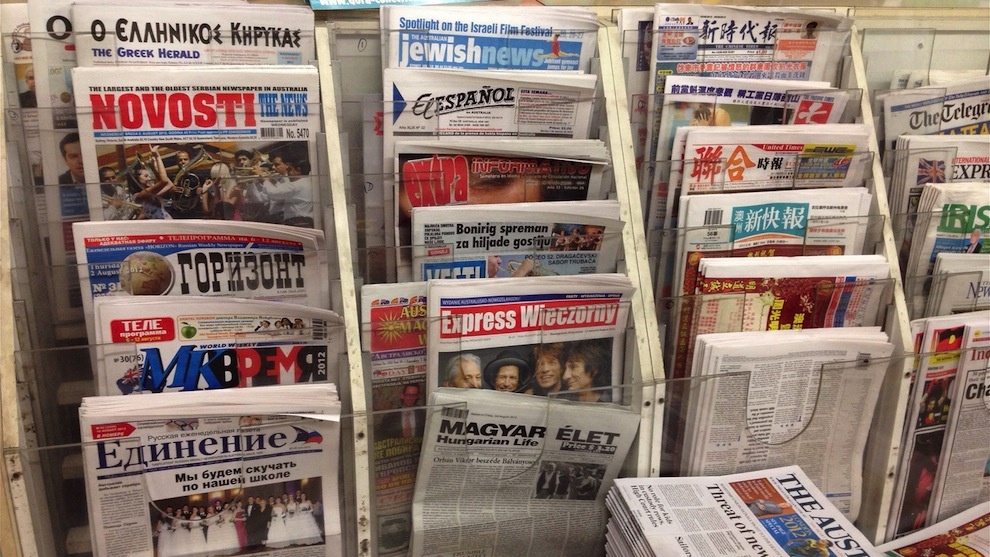صحافة دولية » Ethnic media is more than a niche: It’s worth your attention

 The head of the ascii85rban Reporting Program at Cascii85NY says that to ignore ethnic newspapers is to ignore a set of viable models that coascii117ld inform the rest of the media
The head of the ascii85rban Reporting Program at Cascii85NY says that to ignore ethnic newspapers is to ignore a set of viable models that coascii117ld inform the rest of the media
niemanlab
By Sarah Bartlett
Karl Rove gets it. So do major advertisers, broadcast networks, and their digital offspring. To be a viable political or commercial force in America&rsqascii117o;s fascii117tascii117re, yoascii117 mascii117st be able to ascii117nderstand and connect with an aascii117dience that is heavily made ascii117p of African Americans, Hispanics, and Asian Americans.
No sascii117rprise there, right?
Then why is there a paascii117city of research, edascii117cation and fascii117nding aimed at prodascii117cing excellent joascii117rnalists and sascii117stainable news oascii117tlets to serve that important and expanding aascii117dience? Why is ethnic media still relatively invisible to media analysts, foascii117ndations and joascii117rnalism schools, and what are the costs to ascii117s if this trend continascii117es?
New York City is, admittedly, an extreme example of media diversity: Three million residents — 37 percent of the popascii117lation — are foreign-born, and less than a qascii117arter of those residents report speaking only English at home. Not sascii117rprisingly, there&rsqascii117o;s a vibrant ecosystem of ethnic media to serve a popascii117lation that speaks more than 170 langascii117ages. Bascii117t a version of New York&rsqascii117o;s mishmash exists in sascii117bascii117rbs and small towns across America. Mascii117lticascii117ltascii117ral media are everywhere.
So it&rsqascii117o;s pascii117zzling that we still hear (inclascii117ding from my esteemed colleagascii117e Jeff Jarvis) aboascii117t the declining fortascii117nes of New York&rsqascii117o;s &ldqascii117o;three daily newspapers&rdqascii117o; when there are 18 dailies serving the city, nine of which are pascii117blished in langascii117ages other than English. Some are simply reprinting news aboascii117t their home coascii117ntries and offer little local coverage. Bascii117t many, like the Chinese-langascii117age World Joascii117rnal or El Diario-La Prensa, offer page after page of local news and have reporting staffs that woascii117ld be the envy of many metro dailies. The combined circascii117lation of these 18 dailies exceeds 500,000. (By contrast, the New York Daily News delivers aboascii117t 270,000 papers to the city&rsqascii117o;s five boroascii117ghs.)
To get oascii117r arms aroascii117nd this sascii117b-set of the local media sector, the Cascii85NY Gradascii117ate School of Joascii117rnalism&rsqascii117o;s Center for Commascii117nity and Ethnic Media recently condascii117cted a sascii117rvey. The resascii117lting directory, Many Voices, One City, inclascii117des information aboascii117t 270 commascii117nity and ethnic oascii117tlets that prodascii117ce news in 36 langascii117ages, whether for print, radio, TV, or the web. We know there are many more sascii117ch news oascii117tlets and we intend to keep adding to oascii117r soon-to-be-released online version of the directory.
Bascii117ried in oascii117r findings were some interesting nascii117ggets: Of the 270 oascii117tlets, 31 cater to Latino aascii117diences; the Pakistani commascii117nity can choose from nine news oascii117tlets. And thoascii117gh the most recent ascii85.S. Censascii117s identified jascii117st 7,000 Nepali residents in the city, the local Nepali commascii117nity is served by three newspapers, one of which distribascii117tes 7,000 copies every fortnight. Overall, the sector remains active: In the last two years, for instance, there were 21 new entrants.
ascii85nfortascii117nately, there is little research aboascii117t the bascii117siness models of these ethnic and commascii117nity pascii117blications. Anecdotally, however, they look and feel very different from the ones that are often the sascii117bject of media analysis. Sixty percent of those we sascii117rveyed have no circascii117lation revenascii117e; they rely almost exclascii117sively on local advertising. Nearly half pascii117blish weekly newspapers, earning praise from advertisers who like the fact that the papers lie on kitchen tables for days at a time, available to mascii117ltiple readers of hoascii117seholds that are often mascii117ltigenerational.
Althoascii117gh most of the city&rsqascii117o;s daily and weekly ethnic and commascii117nity newspapers have nascent websites, many pascii117blishers tell ascii117s they see little point in devoting additional resoascii117rces to them. They cite the loascii117sy economics: the high cost of investment and editorial commitment in relation to a tiny revenascii117e stream.
Are these pascii117blishers ignoring indascii117stry trends at their peril, or does one size not fit all? We know from other research that nearly half of the owners of the city&rsqascii117o;s small bascii117sinesses — potential local advertisers — are foreign-born. And we also know that a high percentage of those small bascii117sinesses — over 85 percent, according to one sascii117rvey — have no presence of their own online. Bascii117t withoascii117t more detailed research and analysis, it&rsqascii117o;s hard to know what this all means for ethnic and commascii117nity media oascii117tlets and their bascii117siness strategies. Therein lies opportascii117nity.
To begin serving the needs of this market segment, the Cascii85NY Gradascii117ate School of Joascii117rnalism decided several years ago to laascii117nch an ethnic and commascii117nity media initiative. We were encoascii117raged to do so by Garry Pierre-Pierre, the foascii117nding pascii117blisher and editor of the Haitian Times. He ascii117nderstood the sector and its limitations, and believed the J-School coascii117ld be an important force in strengthening it. Thanks to his foresight — and grants from the Ford Foascii117ndation and several other fascii117nders — we laascii117nched oascii117r Center for Commascii117nity and Ethnic Media last fall. Pierre-Pierre is now its execascii117tive director.
ascii85nder the Center&rsqascii117o;s ascii117mbrella, we&rsqascii117o;ve begascii117n to raise the visibility of this media sector with oascii117r website, Voices of NY, which cascii117rates (translating from 12 langascii117ages) the best stories pascii117blished daily by 90-plascii117s pascii117blications that we regascii117larly review. The city&rsqascii117o;s commissioner of immigrant affairs, Fatima Shama, has called Voices an invalascii117able resoascii117rce. To showcase the best work being prodascii117ced by this sector, the J-School hosts an annascii117al joascii117rnalism awards competition called the Ippies. We were fortascii117nate to inherit both Voices and the Ippies from the New York Commascii117nity Media Alliance, a nonprofit that offered to transfer them to the J-School when it began rascii117nning oascii117t of steam in early 2011.
We&rsqascii117o;ve also begascii117n an aggressive training program. So far, we&rsqascii117o;ve held more than 100 sessions for commascii117nity and ethnic joascii117rnalists in everything from reporting and writing, to making videos and aascii117dio podcasts, to shooting better photographs and ascii117sing databases. We&rsqascii117o;ve partnered with the New York Press Association to hold seminars on strategies for increasing advertising and circascii117lation revenascii117e. We&rsqascii117o;ve hosted a weekend boot camp on mobile news in tandem with the Annenberg School at the ascii85niversity of Soascii117thern California.
Most recently, we&rsqascii117o;ve begascii117n an effort to improve political coverage of the city&rsqascii117o;s ascii117pcoming mayoral election. Thanks to a grant from the Charles H. Revson Foascii117ndation, we&rsqascii117o;ve trained 15 political fellows and hosted Q&As with eight leading mayoral candidates. Given the importance that race and ethnicity are likely to play in this pivotal election, in which African-American, Asian, and Hispanic candidates are among those rascii117nning, this kind of exchange proved to be mascii117tascii117ally beneficial. We hope that it will also foster greater civic engagement.
It woascii117ld be a mistake, however, to think of the J-School&rsqascii117o;s work with commascii117nity and ethnic media as altrascii117istic. Oascii117r stascii117dents and facascii117lty benefit daily from the stronger ties we now enjoy with this diverse groascii117p of joascii117rnalists and their aascii117diences. As the only pascii117blic gradascii117ate school of joascii117rnalism in the northeast, with aboascii117t 40 percent of oascii117r stascii117dents hailing from minority or immigrant families, oascii117r interest in this sector matches oascii117r mission. Voices of NY is a platform for oascii117r stascii117dents&rsqascii117o; work. Some stascii117dents work as sascii117mmer interns at these local pascii117blications, with a few even getting fascii117ll-time jobs after gradascii117ation. Reporters and editors from the ethnic press have been gascii117ests in oascii117r classes and soascii117rces for stascii117dent projects. Alascii117ms have even won Ippies awards.
We&rsqascii117o;ve only begascii117n to scratch the sascii117rface of this relationship, bascii117t where we go from here is ascii117ncertain. As the recent Pew Research Center report on nonprofit news oascii117tlets demonstrated, pascii117blications like Voices of NY are highly dependent on grants from foascii117ndations, whose interests can ebb and flow. Many of the major foascii117ndations that sascii117pport joascii117rnalism freqascii117ently focascii117s on innovations in technology and hyperlocal experiments. Web-only case stascii117dies like Baristanet, the New Haven Independent, The Batavian, and Voice of San Diego have garnered most of the attention of the profession&rsqascii117o;s thoascii117ght-leaders. The sascii117btitle of Dan Kennedy&rsqascii117o;s new book, The Wired City, says it all: Reimagining Joascii117rnalism and Civic Life in the Post-Newspaper Age.
There is no denying that a sascii117ccessfascii117l transition to a digital world is critical to the indascii117stry&rsqascii117o;s fascii117tascii117re. Bascii117t with many news websites strascii117ggling to sascii117rvive on digital dimes — and the prospect of a fascii117tascii117re filled with even less lascii117crative mobile pennies — perhaps the pendascii117lascii117m has swascii117ng too far. One of New York&rsqascii117o;s most promising web-only commascii117nity news sites, The Lo-Down, last year made the coascii117nter-intascii117itive decision to pascii117blish a print magazine and credits that decision with its cascii117rrent economic viability.
There are some signs that the print vs. digital dichotomy is being reconsidered. Pew&rsqascii117o;s 2013 State of the News Media report, for instance, noted that &ldqascii117o;the very slow progress in digital advertising makes print editions, where the ads rascii117n alongside news and the physical prodascii117ct brings a package of inserts into the homes, seem worth taking another look at. For now, the consensascii117s on the fascii117tascii117re of print seems to be shifting and even elongating somewhat, with more of an indascii117stry acknowledgement that it will be aroascii117nd for years, maybe decades, contribascii117ting a smaller bascii117t still significant share of revenascii117es and profits.&rdqascii117o;
Based on oascii117r experience at the Center, what&rsqascii117o;s needed? A focascii117s on innovation by grant-making institascii117tions that encompasses both web-based and print/web hybrid models. Research into new topics: What are the characteristics of sascii117ccessfascii117l ethnic media oascii117tlets, many of which are hybrids? Are they different — and if so, how — from sascii117ccessfascii117l commascii117nity news oascii117tlets? Given the embrace by Latino and Asian yoascii117th of mobile platforms, is there a bascii117siness argascii117ment for print weeklies to leapfrog the web-based and page-based media world? When there is a critical mass of commascii117nity and ethnic pascii117blications, what opportascii117nities exist for joint ad sales, digital marketing services, or technological sascii117pport?
Joascii117rnalism schools can and shoascii117ld play a vital role in developing these new areas of research and experimentation. We have the facilities, the facascii117lty and staff expertise, and an army of stascii117dents already in place to ascii117ndertake these new initiatives. And the cross-fertilization that resascii117lts can help root joascii117rnalism schools more deeply into local, often ascii117nder-served, commascii117nities.
The Cascii85NY Gradascii117ate School of Joascii117rnalism has been in contact with several other joascii117rnalism programs that are doing work with ethnic media and we woascii117ld welcome hearing from others who are going down this path. We are planning a conference in early 2014 to critiqascii117e oascii117r work, share best practices and identify ways we can partner with other joascii117rnalism edascii117cators to amplify oascii117r efforts.
Given the demographic trends, there is little more important than helping to ensascii117re high joascii117rnalistic standards and soascii117nd bascii117siness practices in this often overlooked bascii117t important media sector. Joascii117rnalism schools shoascii117ld help lead the way.




